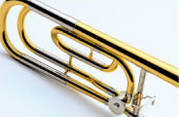The Structure of the Trombone
[Experiment]I can only extend my right arm so far!
Can the trombone be comfortably played by women and children?
Each trombone has a maximum slide position it can be played at. For a tenor trombone this is around 60 cm. This is right around the maximum distance that the average Japanese adult male can extend his arm.
However, what if your arms are simply not long enough? One clever way of overcoming this is to attach a string to the slide, allowing you to reach the farthest slide position.
The reason you extend your arm, in the end, is to extend the length of the tube. Trombone manufacturers then came up with an idea. Why not attach another piece of tubing somewhere on the instrument? Doing so would allow the player's breath to pass through this new piece only when needed.
This additional tubing also plays a role in extending the bass range of the trombone. For tenor trombones, this extends the range from B♭ (their fundamental pitch) to A, G, and F. The additional tubing is thus called an "F attachment." A valve must also be installed to use this additional tubing.
This has made it possible for even smaller people to play the trombone.

The coil-like tubing on the inside is the F attachment.The round silver object is the valve.
Does the valve make the instrument easier to play?
The valve makes it easier to play low notes without having to extend your arm as much, and can even be switched out to change the sound completely.
There are even bass trombones with two valves. Turning on and off the two valves gives a total of four combinations, for four different sounds.
Trombone valves were first invented in the 19th century. Until then, it was extremely difficult to play continuously from, say, B♭ to C. Valves now make this easy.
Example of a bass trombone with two valves being played
Musical Instrument Guide:Trombone Contents
Structure
How to Play
How the Instrument is Made
Choosing an Instrument
Care and Maintenance
Trivia
- God is in the trombone
- The trombone was a bit of a problem for cavalries...
- A trombone that would scare even a snake!
- Two instruments, both tenor, but quite different!
- A trombone player walks into pawnshop...
- You can trill just by moving your mouth
- It is possible to increase the pitch even as you extend the slide
- Famous pieces from trombone concertos
- Orchestra pieces in which the trombone plays an important role
- The Yamaha quartet
- For trombones, why does sheet music notation differ from the fundamental tone of the instrument?
- A bass trombone-with an F attachment only
